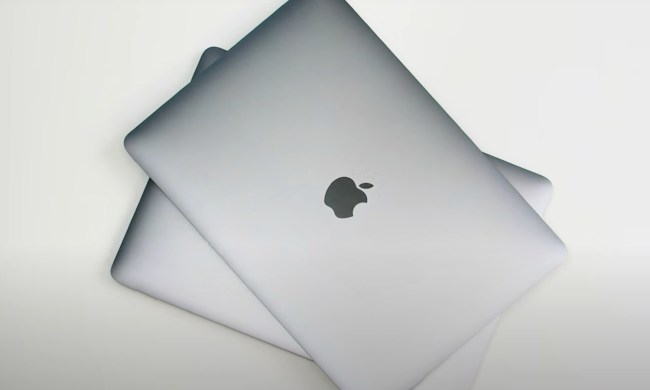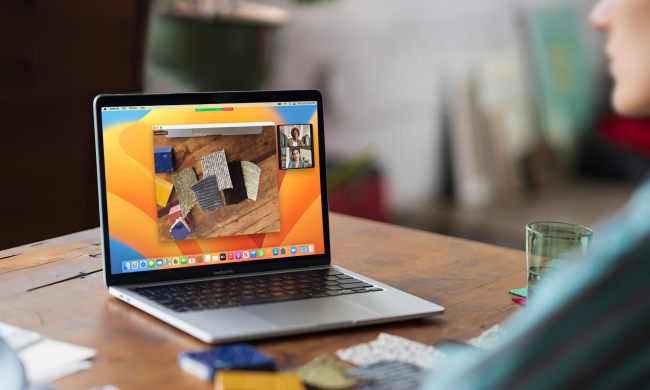With the launch of the new M1 iMac in late April, Apple now has a full lineup of products featuring their new in-house silicon. However, if you’re stuck between a full-fledged office setup and something more portable, you’re more than likely stuck between the new iMac and the 13-inch M1 MacBook Pro.
In this article, we stack up the pros and cons of each to determine which one is best for most people. For more on Apple’s M1 products, check out our reviews for the M1 iMac and the MacBook Pro.
Design">Design
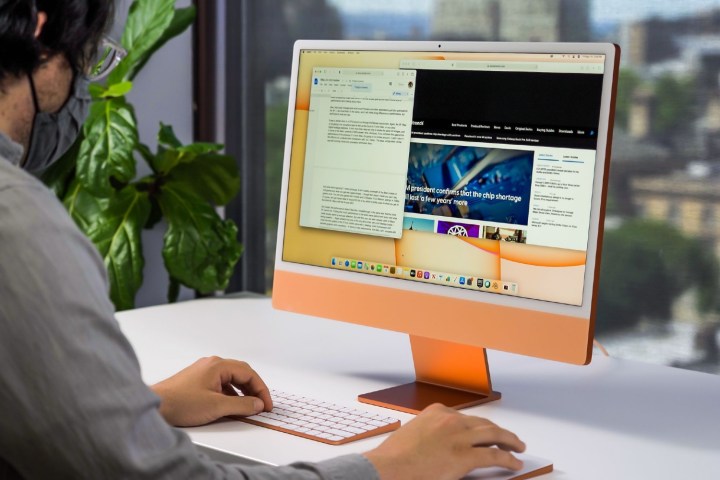
The designs for both the iMac and the MacBook Pro are lovely and well-engineered. However, one is all too familiar, and the other is fresh and exciting.
While the M1 MacBook Pro is an impressive computing device, it still looks like the MacBook we have become accustomed to over the past few years. It still has the minimal and industrial-looking aluminum, and the design is largely unchanged from the last model. It has a 13.3-inch Retina display with a 2560 x 1600 resolution. Even though the Retina display has been around for a while, it still looks stunning. The trackpad is also suitably large and comfortable to use. While it still looks great, the only thing that has changed about the MacBook Pro is the M1 chip inside of it.
The iMac was similarly unchanged — that is until the latest model was released. The 2021 iMac got a top-down redesign, though the chin bar is still prominent. The first thing buyers notice is the variety of colors and how remarkably thin it is. The entire computer is just 11.5mm thick, and it weighs under 10 pounds. That is remarkably thin and light for an all-in-one PC, and it’s all thanks to the M1 processor. The iMac also gets new color options with the latest update. Gone are the days of a simple silver iMac. Now buyers can pick between green, yellow, orange, pink/red, purple, and blue, along with the classic silver.
The next thing you will notice about the new iMac is the larger display. The new model sits between the two older models with a 24-inch display, compared to the prior 21.5-inch and 27-inch versions. The resolution is 4.5K (4480 x 2520) and has a peak brightness of 500 nits.
When it comes to design, we certainly lean more toward the new iMac. While the MacBook Pro still looks excellent, the iMac better embodies the fresh era Apple is stepping into with the M1.
Features">Features

Since Apple developed both machines, they share a lot of the same features. Let’s first look at what makes these two computers distinct from one another.
The most obvious thing the MacBook Pro has that the iMac doesn’t have is the TouchBar. The TouchBar is essentially a tiny touchscreen that replaces the function key row on newer MacBook Pro models. While it has some nifty uses in certain apps, the TouchBar is virtually overlooked and under-supported. There are some good TouchBar apps out there, but don’t be surprised if the screen itself is phased out or significantly changed over the next few generations.
The MacBook Pro was one of the first laptops to sport a large touchpad, and the M1 MacBook Pro has the same one we have seen in prior generations. Like much of Apple’s features, there isn’t any reason to improve on it. The touchpad is high-quality and responsive, and it supports swipe gestures baked into MacOS.
In terms of customization, the M1 MacBook Pro is more limited than prior generations, and the same is true of the iMac. All models come with the M1 chip with 8GB of unified memory and 256GB internal storage. Buyers can upgrade up to 16GB of unified memory and up to 2TB of storage. On the side, you get two Thunderbolt/USB 4 ports and a headphone jack. It’s not overly robust, but it is what we have come to expect on the MacBook lineup.
The M1 MacBook Pro also moves away from Apple’s failure-prone butterfly switches and back to the beloved scissor-switch Magic Keyboard. It’s one of the best typing experiences on the market and a standout feature of the computer. The last highlight feature is the battery life, rated for 17 hours. That’s a substantial amount that stands well above the competition.
What’s not a standout is the 720p webcam. Despite looking dated already, the M1 MacBook Pro has new image processing data that makes the image look even worse more often than not. But, the MacBook makes up for this with its incredible built-in microphone array and stereo speakers that are louder and clearer than most others in the industry.
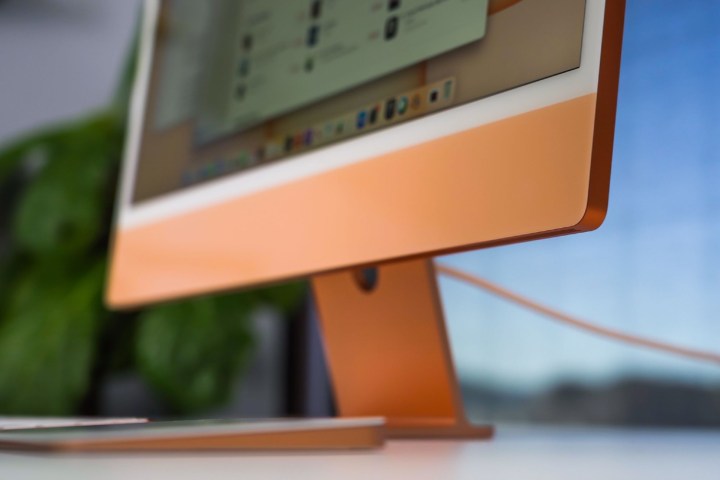
Now on to the iMac. Aside from the M1 chip and the new design, Apple has added quite a bit to this iteration. While critics have bemoaned the decision to include a chin bar on the iMac, it houses a new six-speaker setup that supports spatial audio. It’s surprisingly high-quality for speakers that are functionally very small.
As for configurations, the base model iMac comes with the M1, a seven-core GPU (the same as the MacBook Air), 8GB of unified memory, and a 256GB solid-state drive. You can customize the iMac to include the 8-core GPU, 16GB of unified memory, and up to 2TB of storage.
The port selection is significantly reduced on the iMac compared to its last iteration. The base model only comes with two Thunderbolt/USB 4 ports, and the upgraded model adds a whopping two additional USB 3 ports. A dongle will be essential for most everyday users. However, the iMac can be configured to include Gigabyte Ethernet, which connects to the external power supply. The iMac also features a much better 1080p webcam.
The Magic Mouse and Magic Keyboard also get a fresh coat of paint with the new lineup. Now both accessories have accent colors matching the color of your iMac. The Magic Keyboard on the higher-end model also includes TouchID, a highly anticipated security feature for the Mac lineup. You can also buy it separately if you so desire.
Otherwise, the big feature on both of these computers is the M1 chip, which delivers incredible performance and power efficiency. While both have their unique features, we are giving this one to the 2021 iMac as well. The webcam is greatly improved, it can be configured to include Gigabyte Ethernet, and other features make it feel like a new device rather than just a refresh. Both leave a lot to be desired on the I/O front, though.
Performance">Performance
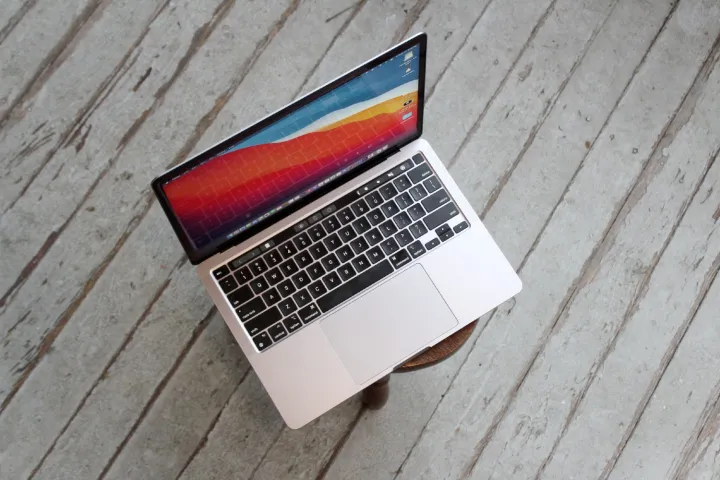
Both of these devices hold the M1 chip, so performance between the two isn’t huge depending on which iMac you compare it to. Every configuration of the MacBook Pro 13 comes with the eight-core GPU, whereas the base model of the iMac comes with the seven-core variant.
What does this mean? For most buyers, nothing. The day-to-day experience between both devices will functionally be the same. Where users would notice a difference is in graphics-intensive software like Photoshop or Steam games. However, even if you opt for the more powerful (and more expensive iMac), you will only experience a 3% boost in performance at most, as we report in our review of the iMac.
The MacBook Pro is an excellent device for power users, and you won’t be missing out on much if you go for it over the iMac. And since the iMac is more expensive, it’s hard to justify the added cost for a marginal improvement.
For that reason, we are giving this section to the MacBook Pro. It offers a lot of performance in a compact and portable package. However, it may be best for the true power users to hold out for the rumored M1X MacBook and iMac variants that will likely be revealed this year.
The 2021 iMac is the more capable all-in-one machine

Both of these devices offer a very similar experience overall. MacOS Big Sur is refined and friendly, and the M1 delivers great performance regardless of what device you choose.
For most people, though, we think the iMac is the better long-term investment. Since both computers have the same processor, it comes down to the other innovations. And with a fresh coat of paint, thin profile, and improved hardware, the iMac is the clear winner.
That may change if and when Apple releases a MacBook Pro with similar changes. Be sure to check here again for the latest updates on Apple products, and see how the iMac stacks up against the Mac Pro.

